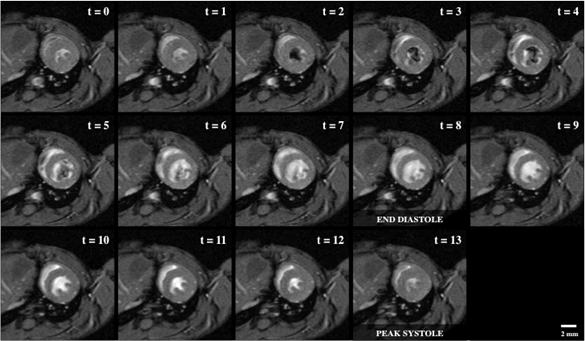心臓磁気共鳴イメージング
概要
出典:フレデリック・W・ダーメンとクレイグ・J・ガーゲン、ウェルドン生物医工学部、パデュー大学、ウェストラファイエット、インディアナ州
このビデオでは、高視野、生理学的モニタリングを有する小さなボア磁気共鳴画像(MRI)が、マウス心血管系のゲートシネループを獲得することが実証されている。この手順は、左心室機能を評価し、血管ネットワークを可視化し、呼吸による臓器の動きを定量化するための基礎を提供する。同等の小動物心血管イメージングモダリティには、高周波超音波およびマイクロコンピュータ断層撮影(CT)が含まれます。ただし、各モダリティは、考慮する必要があるトレードオフに関連付けられています。超音波は高い空間的および時間的な決断を提供するが、イメージングアーティファクトは一般的である。例えば、緻密な組織(すなわち、胸骨および肋骨)は、イメージング浸透深さを制限することができ、および気体と液体との界面における高周エコー信号(すなわち、肺を取り巻く胸膜)は、近くの組織においてコントラストをぼかすことができる。対照的にマイクロCTは、多くの面内アーティファクトに苦しんではいませんが、時間分解能が低く、柔らかい組織のコントラストが制限されています。さらに、マイクロCTはX線放射を使用し、多くの場合、放射線損傷や腎損傷を含む高用量で副作用を引き起こすことが知られている血管系を可視化するために造影剤の使用を必要とします。心血管MRIは、電離放射線の必要性を否定し、造影剤なしで画像を画像化する能力をユーザーに提供することによって、これらの技術間の素晴らしい妥協を提供します(ただし、造影剤はMRIにしばしば使用されます)。
このデータは、呼吸中の心臓サイクルおよび呼吸高原のRピークからゲートオフされたトリガ高速低角度SHot(FLASH)MRI配列で取得された。これらの生理学的事象は、皮下電極および腹部に対して固定された感圧枕を通して監視された。マウスが適切に温かされたことを確認するために、直腸温度プローブを挿入し、MRI安全加熱ファンの出力を制御するために使用しました。動物がMRIスキャナーの穴に挿入され、位置決めを確認するためにナビゲーションシーケンスが実行されると、ゲートFLASHイメージングプレーンが処方され、データが取得されました。全体的に、高磁場MRIは、小動物疾患モデルの研究のための柔らかい組織のコントラストを提供することができる強力な研究ツールです。
手順
1. 動物の調製
- ケージ内で画像化するマウスを識別し、麻酔誘導室に移します。
- イソフルランを使用してマウスを麻酔し、つま先ピンチ技術を使用してノックダウンを確認します。親指と人差し指の間の足を取り、しっかりとピンチして応答を確認します。動物が足を引きこもった場合は、承認されたプロトコルに従って麻酔で待つか、再投与する必要があります。
- イメージング施設に入るスタッフ全員がMRセーフであることを確認してください。これには、磁気衣類/アクセサリーの取り外し、磁気インプラントやペースメーカーの確認、ピアスを含む金属の除去などが含まれます。
- MRIルームのノセコーンへのオープンアイソフルランフロー。これにより、動物が目を覚まさないようにマウス転写前に麻酔薬で長いチューブをプライミングすることができます。
- 麻酔誘導室へのアイソフルランの流れを閉じ、マウスを撮像段階に移す。心臓のおおよその位置が磁石の中心に揃うように、マウスをステージ上に置きます。
- つま先ピンチテクニックを使用して、ノーズコーンを固定し、ノックダウンを再確認します。
結果
申請書と概要
タグ
スキップ先...
このコレクションのビデオ:

Now Playing
心臓磁気共鳴イメージング
Biomedical Engineering
14.8K 閲覧数

光学・共焦点顕微鏡による生体試料のイメージング
Biomedical Engineering
35.8K 閲覧数

生体試料のSEMイメージング
Biomedical Engineering
23.8K 閲覧数

ナノドラッグキャリアのバイオディストリビューション:SEMの応用
Biomedical Engineering
9.3K 閲覧数

腹部大オルタの高周波超音波イメージング
Biomedical Engineering
14.5K 閲覧数

腹部大動脈瘤の定量的ひずみマッピング
Biomedical Engineering
4.6K 閲覧数

インフラレナル大オルタにおける血液と脂質を画像化する光音響断層撮影
Biomedical Engineering
5.7K 閲覧数

脳動脈瘤における血流の計算流体力学シミュレーション
Biomedical Engineering
11.8K 閲覧数

腹部大動脈瘤の近赤外蛍光イメージング
Biomedical Engineering
8.3K 閲覧数

非侵襲的な血圧測定技術
Biomedical Engineering
11.9K 閲覧数

心電図(心電図)信号の獲得と解析
Biomedical Engineering
105.9K 閲覧数

リバーブルバイオマテリアルの引張強度
Biomedical Engineering
7.5K 閲覧数

マウス脊髄のマイクロCTイメージング
Biomedical Engineering
8.0K 閲覧数

ラットにおける非侵襲的ACL損傷後の膝関節変性の可視化
Biomedical Engineering
8.2K 閲覧数

SPECTとCTイメージングを組み合わせて心臓機能を可視化
Biomedical Engineering
11.0K 閲覧数
Copyright © 2023 MyJoVE Corporation. All rights reserved
